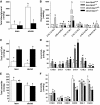Glycerol-3-phosphate acyltransferase 1 deficiency in ob/ob mice diminishes hepatic steatosis but does not protect against insulin resistance or obesity
- PMID: 20200319
- PMCID: PMC2874692
- DOI: 10.2337/db09-1380
Glycerol-3-phosphate acyltransferase 1 deficiency in ob/ob mice diminishes hepatic steatosis but does not protect against insulin resistance or obesity
Abstract
Objective: Hepatic steatosis is strongly associated with insulin resistance, but a causal role has not been established. In ob/ob mice, sterol regulatory element binding protein 1 (SREBP1) mediates the induction of steatosis by upregulating target genes, including glycerol-3-phosphate acyltransferase-1 (Gpat1), which catalyzes the first and committed step in the pathway of glycerolipid synthesis. We asked whether ob/ob mice lacking Gpat1 would have reduced hepatic steatosis and improved insulin sensitivity.
Research design and methods: Hepatic lipids, insulin sensitivity, and hepatic insulin signaling were compared in lean (Lep(+/?)), lean-Gpat1(-/-), ob/ob (Lep(ob/ob)), and ob/ob-Gpat1(-/-) mice. RESULTS Compared with ob/ob mice, the lack of Gpat1 in ob/ob mice reduced hepatic triacylglycerol (TAG) and diacylglycerol (DAG) content 59 and 74%, respectively, but increased acyl-CoA levels. Despite the reduction in hepatic lipids, fasting glucose and insulin concentrations did not improve, and insulin tolerance remained impaired. In both ob/ob and ob/ob-Gpat1(-/-) mice, insulin resistance was accompanied by elevated hepatic protein kinase C-epsilon activation and blunted insulin-stimulated Akt activation.
Conclusions: These results suggest that decreasing hepatic steatosis alone does not improve insulin resistance, and that factors other than increased hepatic DAG and TAG contribute to hepatic insulin resistance in this genetically obese model. They also show that the SREBP1-mediated induction of hepatic steatosis in ob/ob mice requires Gpat1.
Figures





Similar articles
-
Thioesterase superfamily member 2 promotes hepatic insulin resistance in the setting of glycerol-3-phosphate acyltransferase 1-induced steatosis.J Biol Chem. 2019 Feb 8;294(6):2009-2020. doi: 10.1074/jbc.RA118.005184. Epub 2018 Dec 6. J Biol Chem. 2019. PMID: 30523156 Free PMC article.
-
Hepatic overexpression of glycerol-sn-3-phosphate acyltransferase 1 in rats causes insulin resistance.J Biol Chem. 2007 May 18;282(20):14807-15. doi: 10.1074/jbc.M611550200. Epub 2007 Mar 27. J Biol Chem. 2007. PMID: 17389595 Free PMC article.
-
Liver-specific inhibition of ChREBP improves hepatic steatosis and insulin resistance in ob/ob mice.Diabetes. 2006 Aug;55(8):2159-70. doi: 10.2337/db06-0200. Diabetes. 2006. PMID: 16873678
-
Regulation of Triglyceride Metabolism. II. Function of mitochondrial GPAT1 in the regulation of triacylglycerol biosynthesis and insulin action.Am J Physiol Gastrointest Liver Physiol. 2007 May;292(5):G1195-9. doi: 10.1152/ajpgi.00553.2006. Epub 2006 Dec 7. Am J Physiol Gastrointest Liver Physiol. 2007. PMID: 17158253 Free PMC article. Review.
-
Transcriptional Regulation of Acyl-CoA:Glycerol-sn-3-Phosphate Acyltransferases.Int J Mol Sci. 2019 Feb 22;20(4):964. doi: 10.3390/ijms20040964. Int J Mol Sci. 2019. PMID: 30813330 Free PMC article. Review.
Cited by
-
Lysophosphatidic acid activates peroxisome proliferator activated receptor-γ in CHO cells that over-express glycerol 3-phosphate acyltransferase-1.PLoS One. 2011 Apr 20;6(4):e18932. doi: 10.1371/journal.pone.0018932. PLoS One. 2011. PMID: 21533082 Free PMC article.
-
Physiological and pathological roles of lipogenesis.Nat Metab. 2023 May;5(5):735-759. doi: 10.1038/s42255-023-00786-y. Epub 2023 May 4. Nat Metab. 2023. PMID: 37142787 Review.
-
How lipid droplets "TAG" along: Glycerolipid synthetic enzymes and lipid storage.Biochim Biophys Acta Mol Cell Biol Lipids. 2017 Oct;1862(10 Pt B):1131-1145. doi: 10.1016/j.bbalip.2017.06.010. Epub 2017 Jun 20. Biochim Biophys Acta Mol Cell Biol Lipids. 2017. PMID: 28642195 Free PMC article. Review.
-
Sterculic Oil, a Natural SCD1 Inhibitor, Improves Glucose Tolerance in Obese ob/ob Mice.ISRN Endocrinol. 2012;2012:947323. doi: 10.5402/2012/947323. Epub 2012 Nov 14. ISRN Endocrinol. 2012. PMID: 23209931 Free PMC article.
-
Fatty Acid Esterification as a NASH Therapeutic Target.Cell Mol Gastroenterol Hepatol. 2024;17(2):311-312. doi: 10.1016/j.jcmgh.2023.10.011. Epub 2023 Nov 17. Cell Mol Gastroenterol Hepatol. 2024. PMID: 37984466 Free PMC article. No abstract available.
References
-
- Zhang Y, Proenca R, Maffei M, Barone M, Leopold L, Friedman JM:: Positional cloning of the mouse obese gene and its human homologue. Nature 1994; 372: 425–432 - PubMed
-
- Yahagi N, Shimano H, Hasty AH, Matsuzaka T, Ide T, Yoshikawa T, Amemiya-Kudo M, Tomita S, Okazaki H, Tamura Y, Iizuka Y, Ohashi K, Osuga J, Harada K, Gotoda T, Nagai R, Ishibashi S, Yamada N: Absence of sterol regulatory element-binding protein-1 (SREBP-1) ameliorates fatty livers but not obesity or insulin resistance in Lep(ob)/Lep(ob) mice. J Biol Chem 2002; 277: 19353–19357 - PubMed
-
- Coleman RA, Lee DP: Enzymes of triacylglycerol synthesis and their regulation. Prog Lipid Res 2004; 43: 134–176 - PubMed
Publication types
MeSH terms
Substances
Grants and funding
- DK-40936/DK/NIDDK NIH HHS/United States
- P30 ES010126/ES/NIEHS NIH HHS/United States
- P30 DK-56350/DK/NIDDK NIH HHS/United States
- U24 DK-59635/DK/NIDDK NIH HHS/United States
- P30 DK034987/DK/NIDDK NIH HHS/United States
- T32 DK007129/DK/NIDDK NIH HHS/United States
- U24 DK059635/DK/NIDDK NIH HHS/United States
- R01 DK040936/DK/NIDDK NIH HHS/United States
- P30 DK056350/DK/NIDDK NIH HHS/United States
- DK-007129/DK/NIDDK NIH HHS/United States
- P30 DK-34987/DK/NIDDK NIH HHS/United States
- DK-056598/DK/NIDDK NIH HHS/United States
- R56 DK056598/DK/NIDDK NIH HHS/United States
- R01 DK056598/DK/NIDDK NIH HHS/United States
LinkOut - more resources
Full Text Sources
Other Literature Sources
Medical
Molecular Biology Databases
Research Materials
Miscellaneous

